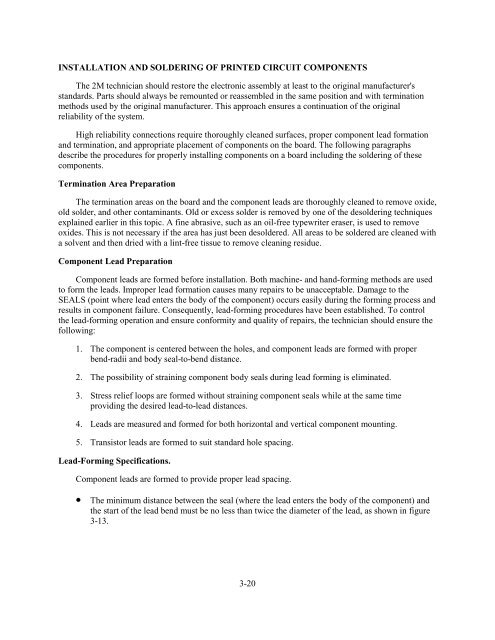Navy Electricity and Electronics Training Series - Historic Naval ...
Navy Electricity and Electronics Training Series - Historic Naval ...
Navy Electricity and Electronics Training Series - Historic Naval ...
You also want an ePaper? Increase the reach of your titles
YUMPU automatically turns print PDFs into web optimized ePapers that Google loves.
INSTALLATION AND SOLDERING OF PRINTED CIRCUIT COMPONENTSThe 2M technician should restore the electronic assembly at least to the original manufacturer'sst<strong>and</strong>ards. Parts should always be remounted or reassembled in the same position <strong>and</strong> with terminationmethods used by the original manufacturer. This approach ensures a continuation of the originalreliability of the system.High reliability connections require thoroughly cleaned surfaces, proper component lead formation<strong>and</strong> termination, <strong>and</strong> appropriate placement of components on the board. The following paragraphsdescribe the procedures for properly installing components on a board including the soldering of thesecomponents.Termination Area PreparationThe termination areas on the board <strong>and</strong> the component leads are thoroughly cleaned to remove oxide,old solder, <strong>and</strong> other contaminants. Old or excess solder is removed by one of the desoldering techniquesexplained earlier in this topic. A fine abrasive, such as an oil-free typewriter eraser, is used to removeoxides. This is not necessary if the area has just been desoldered. All areas to be soldered are cleaned witha solvent <strong>and</strong> then dried with a lint-free tissue to remove cleaning residue.Component Lead PreparationComponent leads are formed before installation. Both machine- <strong>and</strong> h<strong>and</strong>-forming methods are usedto form the leads. Improper lead formation causes many repairs to be unacceptable. Damage to theSEALS (point where lead enters the body of the component) occurs easily during the forming process <strong>and</strong>results in component failure. Consequently, lead-forming procedures have been established. To controlthe lead-forming operation <strong>and</strong> ensure conformity <strong>and</strong> quality of repairs, the technician should ensure thefollowing:1. The component is centered between the holes, <strong>and</strong> component leads are formed with properbend-radii <strong>and</strong> body seal-to-bend distance.2. The possibility of straining component body seals during lead forming is eliminated.3. Stress relief loops are formed without straining component seals while at the same timeproviding the desired lead-to-lead distances.4. Leads are measured <strong>and</strong> formed for both horizontal <strong>and</strong> vertical component mounting.5. Transistor leads are formed to suit st<strong>and</strong>ard hole spacing.Lead-Forming Specifications.Component leads are formed to provide proper lead spacing.• The minimum distance between the seal (where the lead enters the body of the component) <strong>and</strong>the start of the lead bend must be no less than twice the diameter of the lead, as shown in figure3-13.3-20

















